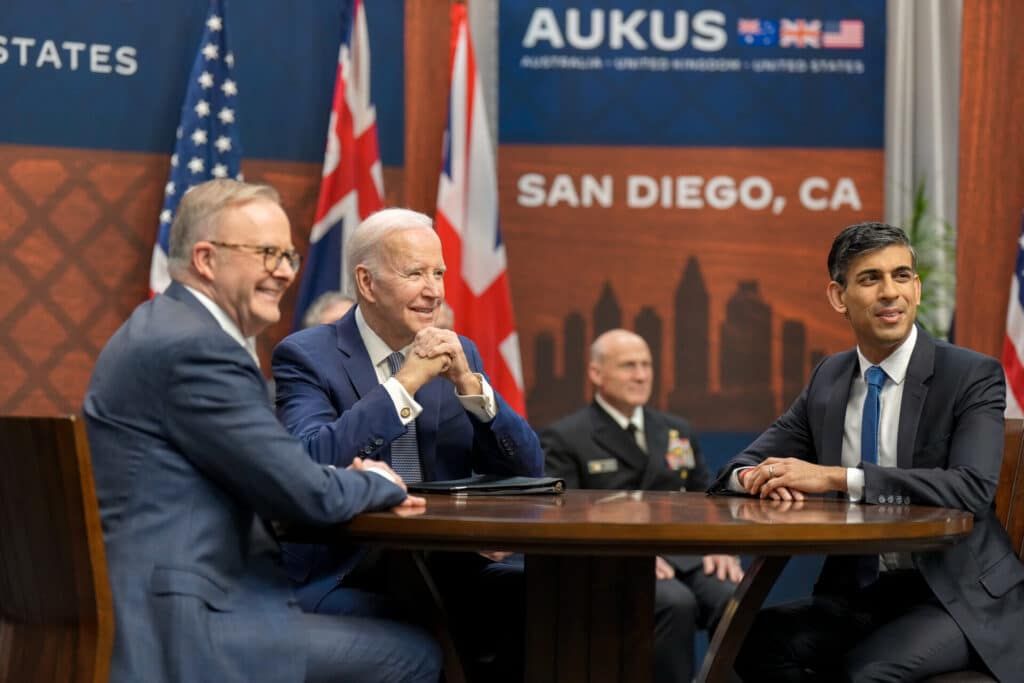What’s next for the AUKUS submarine deal?
By Noah C. Mayhew | April 25, 2023
 Australian Prime Minister Anthony Albanese, US President Joe Biden, and UK Prime Minister Rishi Sunak met on March 13, 2023, to announce the next steps in the AUKUS partnership. Credit: President Biden/Twitter via Wikimedia Commons
Australian Prime Minister Anthony Albanese, US President Joe Biden, and UK Prime Minister Rishi Sunak met on March 13, 2023, to announce the next steps in the AUKUS partnership. Credit: President Biden/Twitter via Wikimedia Commons
Last year I asked everyone to take a deep breath about the trilateral Australia-United Kingdom-United States (AUKUS) submarine deal, in which the United States and the United Kingdom agreed to assist Australia in acquiring nuclear-powered submarines. There really wasn’t anything to panic about, at least until we knew more about what the deal would entail.
Last month, US President Joe Biden, UK Prime Minister Rishi Sunak, and Australian Prime Minister Anthony Albanese stood at Naval Base Point Loma in California and told us what would be next: The submarine deal would proceed in a “phased approach.”
The Chinese delegation in Vienna—historically quite reserved in the Vienna scene—has been extremely vocal about their opposition to AUKUS. At least in Vienna, this represents a change in political positioning on China’s part, which will be important to watch as the submarine deal moves forward.
However, there still isn’t anything to panic about.
Asked and answered. The initial announcement of the AUKUS partnership came in September 2021, launching an 18-month consultation period to identify “an optimal pathway” for transferring nuclear-powered (not nuclear-armed) submarines to Australia. The consultation period included a number of technical meetings with the International Atomic Energy Agency (IAEA) on the legal and technical implications of using nuclear material in Australian submarines. The plan that followed has three phases.
Phase One entails an increase in UK and US submarine port visits to Australia and the training of Australian submariners on these submarines starting this year. This phase will be particularly important for Australia to support a submarine capability, as the Royal Australian Navy has had difficulties in the past crewing its existing diesel-powered Collins-class submarines and has struggled to keep more than three of its six submarines ready for service.
Forward rotations of US and UK submarines to Australia will begin as early as 2027. The AUKUS partners have been careful to clarify that these submarines will not be based in Australia, but rather will maintain a rotational presence to allow Australian submariners opportunities for further training.
Phase Two will be the sale of at least three (and up to five, if needed) US Virginia-class submarines in the early 2030s. They will replace the Collins-class submarines that are due to be retired. The sale of the Virginia-class submarines will be subject to approval by the US Congress, which is not a foregone conclusion considering the state of American politics. If approved, the Virginia-class submarines will be delivered pre-fueled, rather than assembled in Adelaide (contrary to previous reports).
Phase Three, perhaps the most interesting, entails the design of an entirely new nuclear-powered, conventionally armed submarine: the SSN-AUKUS. It will be based on a British design, incorporating American and Australian technology. The British were already developing a new SSN design when the AUKUS partnership was announced, so building on that work was considered the most efficient path forward. Both Australia and the United Kingdom will use SSN-AUKUS submarines, to simplify maintenance.
Construction of the new boats will take place in Australia, while the nuclear fuel will be provided by the United Kingdom or, more likely, the United States. The fuel will be delivered in a complete, welded power unit, which will be installed in the reactor.
The current Australian diesel-powered submarines already use some US technology, but the SSN-AUKUS will go a step further. At last month’s announcement, Australian Prime Minster Albanese pointed out that the partners were “already sharing skills and knowledge and expertise across our borders, lifting the capability and capacity of all three countries.” Though he did not go into detail, one example provided in this document published by the Australian Department of Defence is the US Navy-developed “combat system,” i.e. the “brain” that controls the submarine’s functionality, which will be used in the new submarine.
In an official note to the IAEA following last month’s announcement, Australian Minister for Foreign Affairs Penny Wong informed the agency that Australia will commence negotiation of a so‑called “Article 14 arrangement” under its safeguards agreement with the IAEA, which is designed to ensure that nuclear material is not diverted for the manufacture of nuclear weapons.
It is notable that Australia has chosen an Article 14 arrangement to satisfy the IAEA’s objectives. Under this arrangement, Australia is acknowledging that naval nuclear propulsion is a military activity, and that its agreement with the IAEA allows for the non-application of safeguards on nuclear materials used in non-prohibited activities. Critics of this arrangement say nuclear propulsion must be considered a military activity when it’s powering a military vehicle.
It’s not clear how an Article 14 arrangement will work, because no country has ever concluded one. Australia’s arrangement will set the precedent by which all future such arrangements will be measured, unless Brazil is able to conclude its own Article 14 arrangement first (Brazil has been negotiating with the IAEA for several months).
Importantly, though, “no safeguards” does not mean no verification. At the end of the day, it doesn’t really matter whether verification measures are defined as the application or non-application of safeguards. As long as the IAEA can continue to provide credible assurance that submarine fuel is not being used to manufacture nuclear weapons, the international community should be satisfied. What makes this tricky is how to verify that without allowing Australia or the IAEA access to sensitive information about the form and content of the reactor fuel.
While the recent announcement answered some questions, others remain.
What will the fuel enrichment level be? One reason this deal has generated so much debate is because the AUKUS countries plan to supply highly enriched uranium fuel for the submarines, the type currently used in US and UK submarines. This is the same material that can be used—with chemical processing and other capabilities that Australia does not have—to manufacture the core of a nuclear weapon.
The AUKUS partners say it would be too technically complex and expensive to design an SSN-AUKUS fueled with low-enriched uranium. Also, using highly enriched uranium ensures that the new submarines will never have to be refueled during their lifetime, which significantly reduces the number of opportunities for the fuel to be diverted.
Is a new design necessary? Since the United States is already planning to sell Australia at least three Virginia‑class submarines, would it not be simpler to just do that? The longstanding friendship among the three AUKUS countries explains the desire to co-design a submarine to some extent, but there may be other reasons for a new design. One reason might be the mutual technological advancement that Albanese mentioned (a new combat system for British, for example). Another reason could be to leave the door open for a more innovative or “safeguardable” design. Because the Collins-class submarines already use some US technology, perhaps the combination of all three countries’ technological resources simply made the most operational sense. The most likely reason, though, is that the United Kingdom was already developing a new submarine design, so partnering on that work is the simplest path forward.
Will Congress and the IAEA approve the deal? It’s not clear how the discussion of submarine sales to Australia will go in Congress. Perhaps the longstanding friendship with Australia will ease that process, but a long debate in Congress could stall that part of the plan for years.
It’s also unclear how the Article 14 arrangement will be negotiated in Vienna and whether a draft arrangement will require approval by the IAEA’s Board of Governors. In IAEA Director General Rafael Mariano Grossi’s statement about the AUKUS announcement, he noted that “once that the arrangement is finalized, it will be transmitted to the Board … for appropriate action.” That could mean that Grossi will simply submit the arrangement to the Board as information. The Board might, however, insist on subjecting such an arrangement to its approval. China and Russia would likely vote against approving the arrangement, but it could still be approved by a majority vote.
How will China react? The Chinese delegation to the IAEA in Vienna has vehemently opposed the submarine deal, going so far as to sling personal insults at Grossi in the past for not opposing it himself, according to those in the room during Board meetings. China has maintained that the submarine deal is illegal on a number of fronts within the international nuclear legal framework (no, it’s not). How will China and the other countries opposed to AUKUS react now that the partners have announced their intention to move forward?
A year ago, I argued that there was no need to panic, because nobody even knew whether AUKUS would advance beyond the consultation period. Today I still see no reason for China or anyone else to panic. The timeline for the submarine deal is very ambitious and likely to run into delays. And if the IAEA and Australia can agree on measures that are acceptable to the agency, to ensure that submarine fuel is not diverted for nuclear weapons development, that would set an important precedent for all future such arrangements regardless of the country concerned.
Together, we make the world safer.
The Bulletin elevates expert voices above the noise. But as an independent nonprofit organization, our operations depend on the support of readers like you. Help us continue to deliver quality journalism that holds leaders accountable. Your support of our work at any level is important. In return, we promise our coverage will be understandable, influential, vigilant, solution-oriented, and fair-minded. Together we can make a difference.
Keywords: AUKUS, China, nuclear-powered submarine
Topics: Nuclear Energy, Nuclear Weapons, Opinion, Voices of Tomorrow














